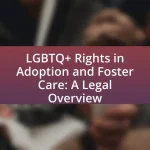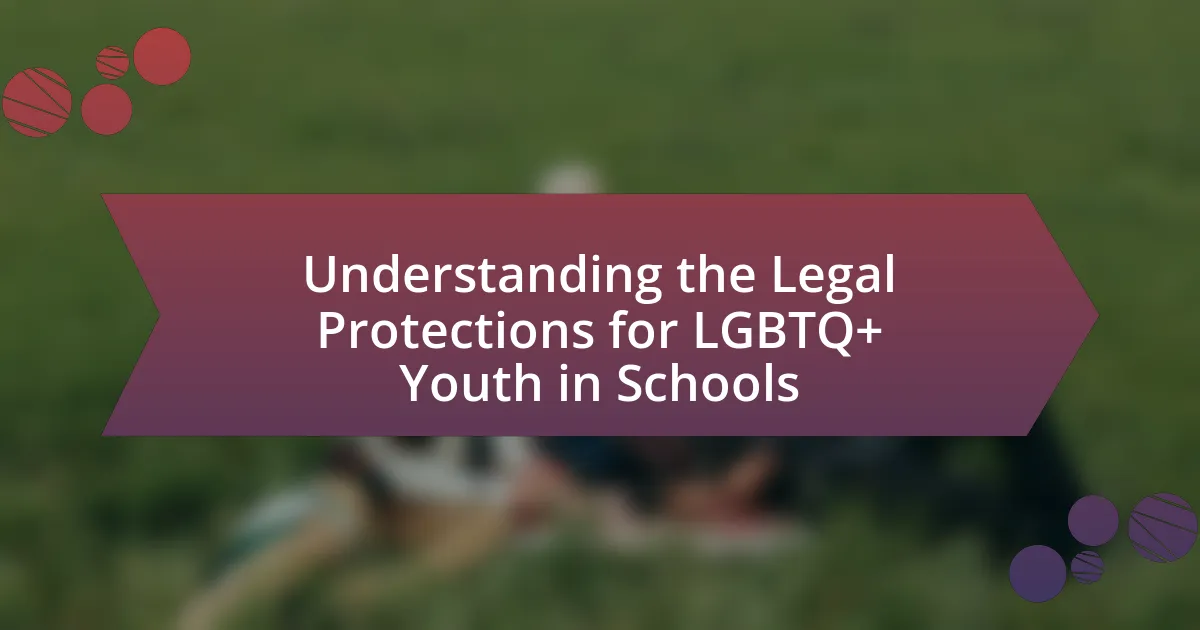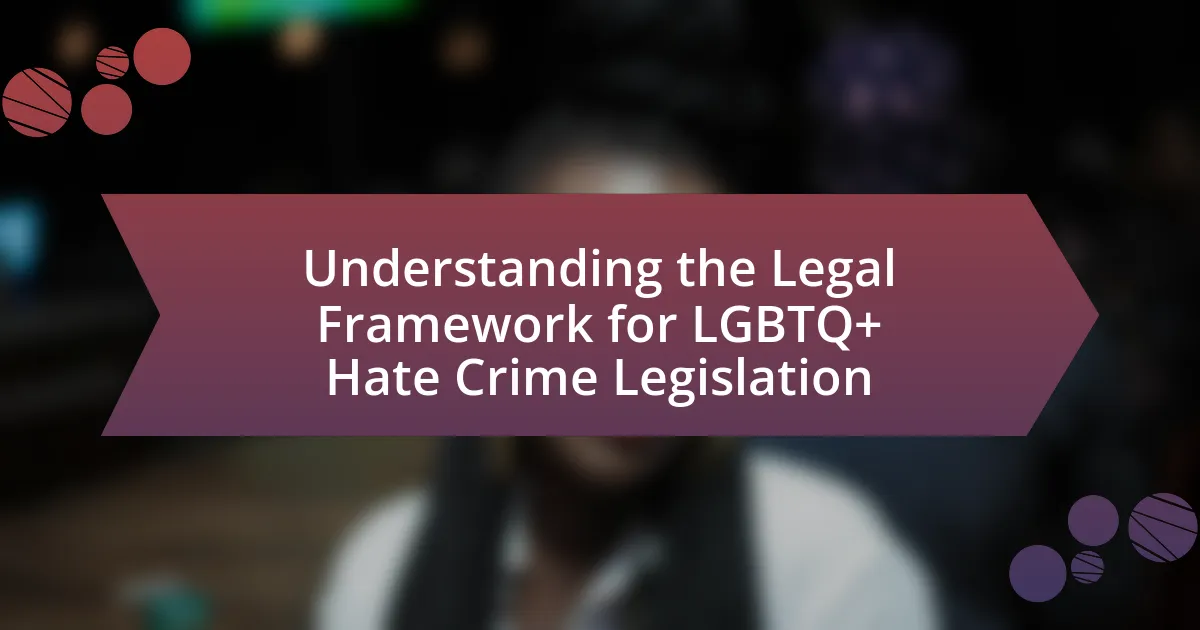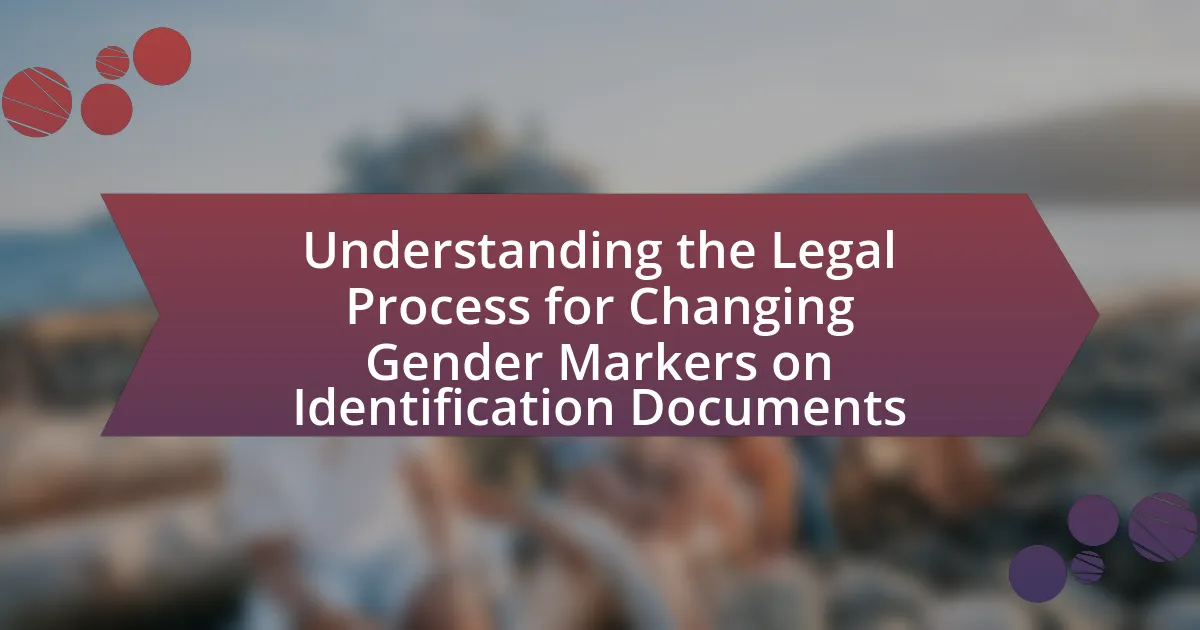Workplace discrimination for LGBTQ+ employees involves unfair treatment based on sexual orientation, gender identity, or gender expression, which can manifest as hiring biases, unequal pay, harassment, and denial of promotions. Legal protections under Title VII of the Civil Rights Act of 1964 prohibit such discrimination, reinforced by the Supreme Court’s ruling in Bostock v. Clayton County. The article outlines the various forms of discrimination faced by LGBTQ+ individuals, the mental health and career implications of such treatment, and the resources available for legal support and advocacy. Additionally, it emphasizes the role of employers in fostering an inclusive workplace and provides practical strategies for LGBTQ+ employees to navigate discrimination effectively.

What is Workplace Discrimination for LGBTQ+ Employees?
Workplace discrimination for LGBTQ+ employees refers to unfair treatment based on an individual’s sexual orientation, gender identity, or gender expression within a professional environment. This discrimination can manifest in various forms, including hiring biases, unequal pay, harassment, and denial of promotions or benefits. According to the U.S. Equal Employment Opportunity Commission, Title VII of the Civil Rights Act of 1964 has been interpreted to prohibit discrimination based on sexual orientation and gender identity, affirming that LGBTQ+ employees are entitled to the same protections as other employees against workplace discrimination.
How is workplace discrimination defined in the context of LGBTQ+ individuals?
Workplace discrimination against LGBTQ+ individuals is defined as unfair treatment based on sexual orientation, gender identity, or gender expression in employment settings. This discrimination can manifest in various forms, including hiring biases, unequal pay, harassment, and denial of promotions or benefits. According to the U.S. Equal Employment Opportunity Commission, Title VII of the Civil Rights Act of 1964 has been interpreted to prohibit discrimination based on sexual orientation and gender identity, reinforcing that such actions are illegal and violate the rights of LGBTQ+ employees.
What are the different forms of discrimination that LGBTQ+ employees may face?
LGBTQ+ employees may face various forms of discrimination, including harassment, unequal pay, denial of promotions, and wrongful termination. Harassment can manifest as verbal abuse, inappropriate comments, or hostile work environments based on sexual orientation or gender identity. Studies indicate that LGBTQ+ individuals often experience pay disparities, with a 2020 report from the Human Rights Campaign revealing that LGBTQ+ employees earn less than their heterosexual counterparts. Denial of promotions frequently occurs when biases against LGBTQ+ identities influence managerial decisions. Additionally, wrongful termination can happen when an employee is fired due to their sexual orientation or gender identity, which is illegal in many jurisdictions but still prevalent. These forms of discrimination contribute to a hostile workplace atmosphere and can significantly impact the mental health and career progression of LGBTQ+ individuals.
Why is understanding workplace discrimination important for LGBTQ+ employees?
Understanding workplace discrimination is crucial for LGBTQ+ employees because it directly impacts their job security, mental health, and overall well-being. Discrimination can manifest in various forms, including harassment, unequal pay, and lack of promotion opportunities, which can lead to a hostile work environment. According to a 2021 report by the Human Rights Campaign, 46% of LGBTQ+ workers reported experiencing discrimination in the workplace, highlighting the prevalence of this issue. Recognizing these challenges enables LGBTQ+ employees to advocate for their rights and seek legal recourse, thereby fostering a more inclusive and equitable workplace.
What legal protections exist for LGBTQ+ employees against workplace discrimination?
LGBTQ+ employees are protected against workplace discrimination under federal law through Title VII of the Civil Rights Act of 1964, which prohibits employment discrimination based on sex, and has been interpreted by the U.S. Supreme Court to include sexual orientation and gender identity. This interpretation was solidified in the landmark case Bostock v. Clayton County, Georgia, where the Court ruled in 2020 that discrimination against an employee for being gay or transgender constitutes sex discrimination. Additionally, many states and local jurisdictions have enacted their own laws that provide further protections against discrimination based on sexual orientation and gender identity, enhancing the legal framework for LGBTQ+ employees.
How do federal laws protect LGBTQ+ employees from discrimination?
Federal laws protect LGBTQ+ employees from discrimination primarily through Title VII of the Civil Rights Act of 1964, which prohibits employment discrimination based on sex. The U.S. Supreme Court’s decision in Bostock v. Clayton County (2020) established that discrimination against an employee for being LGBTQ+ is a form of sex discrimination, thus extending protections to sexual orientation and gender identity. This landmark ruling confirmed that employers cannot fire or discriminate against employees based on their LGBTQ+ status, reinforcing the legal framework for workplace equality.
What state-specific laws enhance protections for LGBTQ+ employees?
State-specific laws that enhance protections for LGBTQ+ employees include non-discrimination statutes in states like California, New York, and Illinois, which explicitly prohibit employment discrimination based on sexual orientation and gender identity. For instance, California’s Fair Employment and Housing Act protects LGBTQ+ individuals from discrimination in hiring, firing, and workplace conditions. Similarly, New York’s Human Rights Law provides comprehensive protections against discrimination based on sexual orientation and gender identity. Illinois also has the Illinois Human Rights Act, which includes protections for LGBTQ+ employees. These laws collectively ensure that LGBTQ+ individuals have legal recourse against discrimination in the workplace, reinforcing their rights and promoting equality.
What are the consequences of workplace discrimination for LGBTQ+ employees?
Workplace discrimination against LGBTQ+ employees leads to significant negative consequences, including mental health issues, decreased job satisfaction, and reduced productivity. Research indicates that LGBTQ+ individuals who experience discrimination are more likely to suffer from anxiety, depression, and stress-related disorders, which can hinder their overall well-being and performance at work. A study by the Human Rights Campaign found that 46% of LGBTQ+ workers reported being treated unfairly in the workplace due to their sexual orientation or gender identity, leading to a hostile work environment that can further exacerbate these mental health challenges. Additionally, discrimination can result in higher turnover rates, as employees may seek more inclusive workplaces, ultimately affecting organizational stability and morale.
How does discrimination impact the mental health of LGBTQ+ employees?
Discrimination significantly harms the mental health of LGBTQ+ employees by increasing stress, anxiety, and depression. Research indicates that LGBTQ+ individuals who experience workplace discrimination report higher levels of psychological distress compared to their heterosexual counterparts. A study published in the Journal of Occupational Health Psychology found that 70% of LGBTQ+ employees who faced discrimination experienced symptoms of anxiety and depression, which can lead to decreased job satisfaction and productivity. Furthermore, the American Psychological Association highlights that such discrimination can result in feelings of isolation and decreased self-esteem, exacerbating mental health issues.
What are the potential career implications for LGBTQ+ employees facing discrimination?
LGBTQ+ employees facing discrimination may experience significant career implications, including reduced job satisfaction, limited career advancement opportunities, and increased mental health issues. Discrimination can lead to a hostile work environment, which negatively impacts productivity and engagement. According to a 2021 report by the Human Rights Campaign, 46% of LGBTQ+ workers reported being discriminated against in the workplace, which can result in higher turnover rates and difficulty in attracting talent. Furthermore, studies indicate that workplaces lacking inclusivity can suffer from decreased employee morale and increased absenteeism, ultimately affecting overall organizational performance.
How can LGBTQ+ employees navigate workplace discrimination effectively?
LGBTQ+ employees can navigate workplace discrimination effectively by understanding their legal rights and utilizing available resources. Familiarizing themselves with anti-discrimination laws, such as Title VII of the Civil Rights Act, which prohibits employment discrimination based on sex, including sexual orientation and gender identity, empowers LGBTQ+ individuals to recognize when their rights are being violated. Additionally, they should document incidents of discrimination, report them to human resources, and seek support from LGBTQ+ advocacy organizations, which can provide guidance and legal assistance. Research indicates that workplaces with inclusive policies see a 30% increase in employee satisfaction, highlighting the importance of addressing discrimination proactively.
What steps should LGBTQ+ employees take if they experience discrimination?
LGBTQ+ employees who experience discrimination should first document the incidents in detail, including dates, times, locations, and witnesses. This documentation serves as crucial evidence when reporting the discrimination. Next, they should report the discrimination to their immediate supervisor or human resources department, as most organizations have policies in place to address such issues. If the internal reporting does not resolve the situation, LGBTQ+ employees can file a complaint with the Equal Employment Opportunity Commission (EEOC) or a similar state agency, which investigates claims of workplace discrimination. According to the EEOC, discrimination based on sexual orientation and gender identity is prohibited under Title VII of the Civil Rights Act of 1964, reinforcing the legal protections available to LGBTQ+ employees. Seeking support from LGBTQ+ advocacy organizations can also provide additional resources and guidance throughout the process.
How can LGBTQ+ employees document incidents of discrimination?
LGBTQ+ employees can document incidents of discrimination by keeping detailed records of each occurrence, including dates, times, locations, and the individuals involved. This documentation should also include a description of the incident, any witnesses present, and any actions taken following the incident, such as reporting it to a supervisor or HR. Research indicates that thorough documentation can strengthen claims of discrimination and is often essential for legal proceedings, as noted in the Equal Employment Opportunity Commission guidelines, which emphasize the importance of evidence in discrimination cases.

What resources are available for LGBTQ+ employees facing discrimination?
LGBTQ+ employees facing discrimination can access several resources, including legal protections, support organizations, and workplace policies. The Equal Employment Opportunity Commission (EEOC) enforces federal laws prohibiting employment discrimination based on sexual orientation and gender identity, providing a legal framework for employees to file complaints. Additionally, organizations such as the Human Rights Campaign and Lambda Legal offer advocacy, legal assistance, and educational resources tailored to LGBTQ+ individuals. Many companies also have diversity and inclusion programs that include specific policies against discrimination, providing internal support systems for affected employees.
How can LGBTQ+ employees access legal support and advocacy?
LGBTQ+ employees can access legal support and advocacy through various organizations and resources dedicated to protecting their rights. These include national organizations like the Human Rights Campaign and Lambda Legal, which provide legal assistance, advocacy, and educational resources specifically for LGBTQ+ individuals facing discrimination. Additionally, many states have local LGBTQ+ advocacy groups that offer legal referrals and support tailored to regional laws and protections. According to a 2021 report by the Williams Institute, approximately 20% of LGBTQ+ individuals have experienced workplace discrimination, highlighting the importance of these resources for legal recourse and support.
What organizations provide assistance to LGBTQ+ employees facing discrimination?
Organizations that provide assistance to LGBTQ+ employees facing discrimination include the Human Rights Campaign (HRC), the Equal Employment Opportunity Commission (EEOC), and Lambda Legal. The Human Rights Campaign advocates for LGBTQ+ rights and offers resources for employees facing discrimination, while the EEOC enforces federal laws prohibiting employment discrimination based on sexual orientation and gender identity. Lambda Legal provides legal representation and support for LGBTQ+ individuals facing discrimination in the workplace. These organizations are recognized for their commitment to protecting the rights of LGBTQ+ employees and providing necessary resources and legal assistance.
How can LGBTQ+ employees find legal representation for discrimination cases?
LGBTQ+ employees can find legal representation for discrimination cases by contacting organizations that specialize in LGBTQ+ rights, such as the Lambda Legal Defense and Education Fund or the Human Rights Campaign. These organizations often provide resources, referrals, and legal assistance specifically tailored to discrimination cases involving LGBTQ+ individuals. Additionally, employees can search for local attorneys who have experience in employment law and LGBTQ+ issues through state bar associations or legal aid services. Research indicates that legal representation significantly increases the likelihood of a favorable outcome in discrimination cases, highlighting the importance of seeking specialized legal help.
What role do employers play in preventing workplace discrimination?
Employers play a crucial role in preventing workplace discrimination by implementing policies and practices that promote equality and inclusivity. They are responsible for creating a work environment that prohibits discriminatory behavior based on sexual orientation, gender identity, and other protected characteristics. For instance, according to the Equal Employment Opportunity Commission (EEOC), employers must ensure compliance with Title VII of the Civil Rights Act, which prohibits employment discrimination. This includes providing training on diversity and inclusion, establishing clear reporting mechanisms for discrimination complaints, and actively promoting a culture of respect and acceptance. By taking these actions, employers not only fulfill their legal obligations but also contribute to a more equitable workplace for LGBTQ+ employees.
How can employers create an inclusive workplace for LGBTQ+ employees?
Employers can create an inclusive workplace for LGBTQ+ employees by implementing comprehensive non-discrimination policies that explicitly protect sexual orientation and gender identity. Research from the Human Rights Campaign indicates that workplaces with inclusive policies experience higher employee satisfaction and retention rates. Additionally, providing diversity training that includes LGBTQ+ issues fosters understanding and respect among all employees, which is crucial for a supportive environment. Establishing employee resource groups for LGBTQ+ staff can also enhance community and support within the organization, further promoting inclusivity.
What policies should employers implement to combat discrimination?
Employers should implement comprehensive anti-discrimination policies that explicitly prohibit discrimination based on sexual orientation and gender identity. These policies should include clear definitions of discrimination, procedures for reporting incidents, and mechanisms for investigating complaints. Research indicates that workplaces with explicit anti-discrimination policies experience a 30% reduction in reported discrimination incidents, highlighting the effectiveness of such measures. Additionally, training programs on diversity and inclusion can further reinforce these policies, fostering a more inclusive environment for LGBTQ+ employees.

What are best practices for LGBTQ+ employees to protect their rights?
LGBTQ+ employees can protect their rights by understanding and utilizing anti-discrimination laws, such as the Equality Act and Title VII of the Civil Rights Act, which prohibit discrimination based on sexual orientation and gender identity. Familiarizing themselves with these laws enables employees to recognize their rights and take action if they experience discrimination. Additionally, documenting incidents of discrimination, seeking support from LGBTQ+ advocacy organizations, and reporting violations to human resources or relevant authorities are crucial steps. Research indicates that workplaces with inclusive policies see a 20% increase in employee satisfaction and retention, reinforcing the importance of these practices.
How can LGBTQ+ employees advocate for themselves in the workplace?
LGBTQ+ employees can advocate for themselves in the workplace by clearly communicating their needs and concerns to management and utilizing available resources such as employee resource groups (ERGs) and human resources (HR). Effective self-advocacy involves understanding workplace policies related to discrimination and harassment, which are often outlined in company handbooks. For instance, the Human Rights Campaign reports that inclusive policies can significantly improve workplace experiences for LGBTQ+ individuals. Additionally, LGBTQ+ employees can document incidents of discrimination or bias, as maintaining a record can support their claims if they choose to escalate the matter. Engaging in open dialogues about diversity and inclusion initiatives can also foster a more supportive environment.
What strategies can LGBTQ+ employees use to raise awareness about discrimination?
LGBTQ+ employees can raise awareness about discrimination by organizing educational workshops and training sessions that highlight the challenges faced by the community. These initiatives can provide factual information about discrimination statistics, such as the 2021 Human Rights Campaign report indicating that 46% of LGBTQ+ workers experienced discrimination in the workplace. Additionally, LGBTQ+ employees can create support networks or affinity groups that foster open discussions about discrimination experiences, thereby promoting a culture of inclusivity. Engaging in advocacy through company policies, such as pushing for anti-discrimination clauses and diversity training, can also effectively raise awareness. By sharing personal stories and data-driven insights, LGBTQ+ employees can help colleagues understand the impact of discrimination, ultimately fostering a more supportive work environment.
How can LGBTQ+ employees build supportive networks within their workplace?
LGBTQ+ employees can build supportive networks within their workplace by actively participating in employee resource groups (ERGs) and seeking mentorship from allies and other LGBTQ+ individuals. Engaging in ERGs fosters a sense of community and provides a platform for sharing experiences and resources, which is crucial for emotional support and professional development. Research indicates that workplaces with ERGs report higher employee satisfaction and retention rates, highlighting their effectiveness in creating inclusive environments. Additionally, establishing connections with allies can enhance visibility and support, as allies often advocate for LGBTQ+ rights and inclusion within the organization.
What practical tips can LGBTQ+ employees use to navigate workplace discrimination?
LGBTQ+ employees can navigate workplace discrimination by documenting incidents, seeking support from allies, and understanding their legal rights. Documenting incidents provides a clear record of discriminatory behavior, which can be crucial for reporting to HR or legal authorities. Seeking support from allies, such as coworkers or employee resource groups, fosters a sense of community and can provide emotional and practical assistance. Understanding legal rights, such as protections under Title VII of the Civil Rights Act, which prohibits employment discrimination based on sex, including sexual orientation and gender identity, empowers employees to take informed action against discrimination.
How can LGBTQ+ employees prepare for discussions about discrimination with HR?
LGBTQ+ employees can prepare for discussions about discrimination with HR by documenting specific incidents of discrimination, gathering relevant policies, and understanding their legal rights. Documenting incidents involves keeping detailed records of dates, times, locations, and descriptions of discriminatory behavior, which provides concrete evidence during discussions. Familiarizing themselves with company policies on discrimination and harassment ensures that employees can reference specific guidelines that support their claims. Additionally, understanding legal protections under laws such as Title VII of the Civil Rights Act, which prohibits employment discrimination based on sex, including sexual orientation and gender identity, empowers employees to advocate for their rights effectively.
What resources can LGBTQ+ employees utilize for ongoing support and education?
LGBTQ+ employees can utilize various resources for ongoing support and education, including organizations like the Human Rights Campaign, which offers educational materials and advocacy resources, and the Trevor Project, which provides crisis intervention and suicide prevention services specifically for LGBTQ+ youth. Additionally, workplace diversity and inclusion training programs can enhance understanding and support within organizations. Research indicates that companies with active LGBTQ+ employee resource groups report higher employee satisfaction and retention rates, demonstrating the effectiveness of these support systems.





